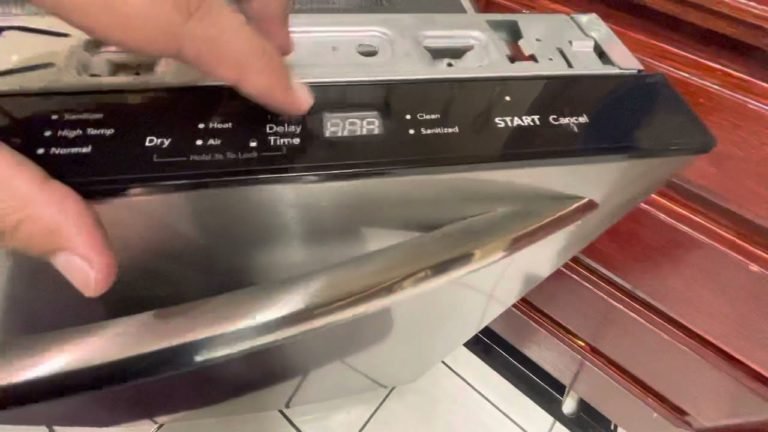
When your Frigidaire dishwasher shows the “OE” error code, it’s trying to tell you something important. Think of your dishwasher as having a voice—actually, it’s more like a tiny, very specific language that utilizes codes! This particular code is indicating an issue with the dishwasher’s drainage system. It’s like when you’re trying to pour water down a clogged sink—it just won’t go anywhere. So, ignoring this message would be like ignoring a clogged pipe; it’s bound to lead to bigger problems. Let’s dive into what you can do about it.
Understanding the “OE” Error Code
First things first, what exactly does the “OE” error code mean? In simple terms, it relates to a drainage issue—your Frigidaire dishwasher is having trouble draining out the water. Imagine trying to drain a bathtub with the plug still in; the water just sits there. This code is somewhat akin to your dishwasher saying, “Help! I can’t get rid of the water!”
You might be wondering, “Why is drainage such a big deal?” When water isn’t properly drained, it can lead to stagnant water sitting at the bottom of the dishwasher, creating a breeding ground for bacteria and mold. Not to mention, it might leave your dishes less than clean, defeating the entire purpose of the appliance. Detecting and fixing drainage issues sooner rather than later can save you from messier, more expensive troubles down the road.
Ignoring this error isn’t a good idea because, ultimately, it can lead to overflow or internal damage. Think of it like ignoring the oil light on your car’s dashboard. Sure, you might get away with it for a while, but eventually, it’s going to cost you. If you leave the “OE” issue unattended, you risk water damage to your kitchen floors or even shorting out the dishwasher’s electrical components. So, it’s best to address it sooner rather than later.
Common Causes of the “OE” Error Code
Now that we know ignoring the error isn’t wise, what causes it in the first place? Often, it’s one of a few common culprits. One likely suspect is a kink or clog in the dishwasher’s drain hose. Picture a garden hose with a strong kink in it—no matter how high you crank the water pressure, nothing’s getting through.
Another possibility could be a blockage in the sink’s garbage disposal. If your dishwasher is connected to the disposal and it’s full or jammed, the water has nowhere to go. It’s similar to trying to pass through a crowded hallway during a fire drill—everything just stops moving.
Lastly, the issue could also arise from a faulty drain pump. This is the component responsible for pushing water out of the dishwasher. If it isn’t working, it’s like trying to blow up a balloon with a hole in it. Without this pump doing its job, the water stays put. Fortunately, diagnosing and fixing these common issues can often be done with a little bit of troubleshooting at home, no professional needed!
Steps to Resolve the “OE” Error
So, how do you fix it? Start by checking the dishwasher’s drain hose. Ensure it’s not kinked or twisted. If it is, simply straighten it out. If the hose seems clear and free-flowing, the next step is to look at the garbage disposal—make sure it’s empty and working properly.
Still having issues? It could be the drain pump. While this might sound daunting, replacing a drain pump is a bit like changing the batteries in a remote—it can appear intimidating at first, but it’s relatively straightforward once you get going. Many user manuals provide step-by-step guidance, or you can consult a repair guide online if needed.
If these steps don’t resolve the issue, it might be time to call in a professional. Hiring an expert to diagnose the problem ensures that any underlying issues are addressed, potentially saving you headaches and money in the future. Much like calling a mechanic for your car, sometimes it’s best to leave it to someone with the know-how.
Preventing Future Errors
Preventing the dreaded “OE” error code in the future involves just a bit of routine maintenance. Regularly clean out your dishwasher’s filter; it’s amazing how much gunk can accumulate there. Think of it like cleaning out the lint trap in your dryer.
Make sure to periodically check the drain hose and keep the garbage disposal clear. It might even be helpful to run a cleaning cycle with vinegar once in a while to keep everything flowing smoothly and reduce odors. It’s like giving your dishwasher a nice spa day, ensuring everything runs as it should.
Finally, pay attention to what you’re putting in your dishwasher. Avoid large food particles or items that could clog the works. Remember, the better you treat your dishwasher, the longer it’ll run without issues. Consider it a friendly reminder from your trusty kitchen appliance that a little care goes a long way.
So, there you have it. When you see that “OE” error code, you now know it’s a signal from your dishwasher asking for some attention. It’s much better to address the issue promptly rather than turning a blind eye and hoping it sorts itself out. Prevention and timely intervention can keep your dishwasher running smoothly and save you from unnecessary costs and headaches in the future.